Public Policies for Renewable Energy: A Review of the Perspectives for a Circular Economy
Abstract
1. Introduction
2. Materials and Methods
2.1. Stage 1—Review Planning
2.2. Stage 2—Conducting the Review
2.3. Step 3—Disclosure Report
3. Results and Discussion
3.1. Bibliometric Analysis
3.1.1. Spatial Distribution of Research
3.1.2. Impact Analysis of Publications
3.1.3. Analysis of the Purpose of the PP
3.1.4. Research Areas
3.1.5. Analysis of Areas Impacted by PP
3.1.6. Indexing Terms
3.2. Systematic Literature Review
3.2.1. Renewable Energy Sources and Public Policies
3.2.2. Analysis of Public Policies Concerning Renewable Energies
3.2.3. Types of Public Policies
3.2.4. CE and Renewable Energy
4. Conclusions
Author Contributions
Funding
Data Availability Statement
Conflicts of Interest
References
- Dye, T. The Policy Analysis; The University of Alabama Press: Tuscaloosa, AL, USA, 1976. [Google Scholar]
- Lasswell, H. The policy orientation. In The Policy Sciences; Lerner, D., Lasswell, H., Eds.; Stanford University Press: Stanford, CA, USA, 1951. [Google Scholar]
- Dror, Y. Design for Policy Sciences; Elsevier: New York, NY, USA, 1971. [Google Scholar]
- Ham, C.; Hill, M. The Policy Process in the Modern Capitalist State; Royal Victorian Institute for the Blind: London, UK, 1993. [Google Scholar]
- Wildavsky, A. Speaking Truth to Power: The Art and Craft of Policy Analysis; Routledge: Boston, MA, USA, 1979. [Google Scholar]
- Marques, A.C.; Fuinhas, J.A.; Pereira, D.S. The dynamics of the short and long-run effects of public policies supporting renewable energy: A comparative study of installed capacity and electricity generation. Econ. Anal. Policy 2019, 63, 188–206. [Google Scholar] [CrossRef]
- Gallagher, J.; Basu, B.; Browne, M.; Kenna, A.; McCormack, S.; Pilla, F.; Styles, D. Adapting Stand-Alone Renewable Energy Technologies for the Circular Economy through Eco-Design and Recycling. J. Ind. Ecol. 2019, 23, 133–140. [Google Scholar] [CrossRef]
- Lowi, T.J. American Business, Public Policy, Case-Studies, and Political Theory. World Politics 1964, 16, 677–715. [Google Scholar] [CrossRef]
- Priyadarshini, P.; Abhilash, P.C. Circular economy practices within energy and waste management sectors of India: A meta-analysis. Bioresour. Technol. 2020, 304, 123018. [Google Scholar] [CrossRef] [PubMed]
- Webster, K. The Circular Economy: A Wealth of Flows; Ellen MacArthur Foundation Publishing: Cowes, UK, 2015. [Google Scholar]
- Gelhard, C.; Von Delft, S. The role of organizational capabilities in achieving superior sustainability performance. J. Bus. Res. 2016, 69, 4632–4642. [Google Scholar] [CrossRef]
- Haas, W.; Krausmann, F.; Wiedenhofer, D.; Heinz, M. How Circular is the Global Economy?: An Assessment of Material Flows, Waste Production, and Recycling in the European Union and the World in 2005. J. Ind. Ecol. 2015, 19, 765–777. [Google Scholar] [CrossRef]
- Mihaela, M.; Daniela, M.; Emilia, T.; Valentina, V. Correlations in the European Circular Economy. Econ. Comput. Econ. Cybern. Stud. Res. 2018, 52, 61–78. [Google Scholar] [CrossRef]
- Hoffman, A.J. Linking Social Systems Analysis to The Industrial Ecology Framework. Organ. Environ. 2003, 16, 66–86. [Google Scholar] [CrossRef]
- Ngan, S.L.; How, B.S.; Teng, S.Y.; Promentilla, M.A.B.; Yatim, P.; Er, A.C.; Lam, H.L. Prioritization of sustainability indicators for promoting the circular economy: The case of developing countries. Renew. Sustain. Energy Rev. 2019, 111, 314–331. [Google Scholar] [CrossRef]
- Batista, A.G.; Betini, R.C.; Bareta, M.L.E.; Sandim, Á.A.; Pepplow, L.A. Public Policies to Be Implemented to Encourage the Use of Renewable Energy Sources in the Rural Area of Paraná. Brazilian Arch. Biol. Technol. 2019, 62. [Google Scholar] [CrossRef]
- Carvalho, M.; de Santana Freire, R.; de Brito, A.M.V.G. Promotion of Sustainability by Quantifying and Reducing the Carbon Footprint: New Practices for Organizations. In Energy, Transportation and Global Warming; Springer: Cham, Switzerland, 2016; pp. 61–72. [Google Scholar]
- Giezen, M. Shifting Infrastructure Landscapes in a Circular Economy: An Institutional Work Analysis of the Water and Energy Sector. Sustainability 2018, 10, 3487. [Google Scholar] [CrossRef]
- Ünal, E.; Shao, J. A taxonomy of circular economy implementation strategies for manufacturing firms: Analysis of 391 cradle-to-cradle products. J. Clean. Prod. 2019, 212, 754–765. [Google Scholar] [CrossRef]
- West, J.; Bailey, I.; Winter, M. Renewable energy policy and public perceptions of renewable energy: A cultural theory approach. Energy Policy 2010, 38, 5739–5748. [Google Scholar] [CrossRef]
- Kitchenham, B.A.; Dyba, T.; Jorgensen, M. Evidence-based software engineering. In Proceedings of the 26th International Conference on Software Engineering, Edinburgh, UK, 28 May 2004; pp. 273–281. [Google Scholar]
- Tranfield, D.; Denyer, D.; Smart, P. Rumo a uma metodologia para desenvolver conhecimento de gestão baseado em evidências por meio de revisão sistemática. Br. J. Manag. 2003, 14, 207–222. [Google Scholar] [CrossRef]
- De Doile, G.N.D.; Rotella Junior, P.; Rocha, L.C.S.; Bolis, I.; Janda, K.; Coelho Junior, L.M. Hybrid Wind and Solar Photovoltaic Generation with Energy Storage Systems: A Systematic Literature Review and Contributions to Technical and Economic Regulations. Energies 2021, 14, 6521. [Google Scholar] [CrossRef]
- Khan, K.S.; Kunz, R.; Kleijnen, J.; Antes, G. Five Steps to Conducting a Systematic Review. J. R. Soc. Med. 2003, 96, 118–121. [Google Scholar] [CrossRef]
- Van Eck, N.J.; Waltman, L. Software survey: VOSviewer, a computer program for bibliometric mapping. Scientometrics 2010, 84, 523–538. [Google Scholar] [CrossRef]
- Cohen, N.; Arieli, T. Field research in conflict environments: Methodological challenges and snowball sampling. J. Peace Res. 2011, 48, 423–435. [Google Scholar] [CrossRef]
- Chadegani, A.A.; Salehi, H.; Yunus, M.M.; Farhadi, H.; Fooladi, M.; Farhadi, M.; Ebrahim, N.A. A Comparison between Two Main Academic Literature Collections: Web of Science and Scopus Databases. Asian Soc. Sci. 2013, 9, p18. [Google Scholar] [CrossRef]
- Azevêdo, R.; Rotela Junior, P.; Chicco, G.; Aquila, G.; Rocha, L.C.; Peruchi, R. Identification and analysis of impact factors on the economic feasibility of wind energy investments. Int. J. Energy Res. 2021, 45, 3671–3697. [Google Scholar] [CrossRef]
- De Oliveira Azevêdo, R.; Rotela Junior, P.; Rocha, L.C.S.; Chicco, G.; Aquila, G.; Peruchi, R.S. Identification and Analysis of Impact Factors on the Economic Feasibility of Photovoltaic Energy Investments. Sustainability 2020, 12, 7173. [Google Scholar] [CrossRef]
- Rotella Junior, P.; Rocha, L.C.S.; Morioka, S.N.; Bolis, I.; Chicco, G.; Mazza, A.; Janda, K. Economic Analysis of the Investments in Battery Energy Storage Systems: Review and Current Perspectives. Energies 2021, 14, 2503. [Google Scholar] [CrossRef]
- Pires, A.L.G.; Rotella Junior, P.; Morioka, S.N.; Rocha, L.C.S.; Bolis, I. Main Trends and Criteria Adopted in Economic Feasibility Studies of Offshore Wind Energy: A Systematic Literature Review. Energies 2021, 15, 12. [Google Scholar] [CrossRef]
- Ensslin, L.; Gonçalves, A.; Ensslin, S.R.; Dutra, A.; Longaray, A.A. Constructivist multi-criteria model to support the management of occupational accident risks in civil construction industry. PLoS ONE 2022, 17, e0270529. [Google Scholar] [CrossRef] [PubMed]
- White, M.; Marsh, E. Content analysis: A flexible methodology. Libr. Trends 2006, 55, 22–45. [Google Scholar] [CrossRef]
- Crespo, A. Estatística Fácil, 15th ed.; Saraiva: São Paulo, Brazil, 1997. [Google Scholar]
- Rackman, N. Spin Selling: Alcançando Excelência em Vendas; M. Books do Brasil Editora Ltda: São Paulo, Brazil, 2009. [Google Scholar]
- Elo, S.; Kyngas, H. O processo qualitativo de análise de conteúdo. J. Enferm. Avançada 2008, 62, 107–115. [Google Scholar]
- Cook, D.J. Systematic Reviews: Synthesis of Best Evidence for Clinical Decisions. Ann. Intern. Med. 1997, 126, 376. [Google Scholar] [CrossRef]
- Loiter, J.M.; Norberg-Bohm, V. Technology policy and renewable energy: Public roles in the development of new energy technologies. Energy Policy 1999, 27, 85–97. [Google Scholar] [CrossRef]
- Barradale, M.J. Impact of public policy uncertainty on renewable energy investment: Wind power and the production tax credit. Energy Policy 2010, 38, 7698–7709. [Google Scholar] [CrossRef]
- Sherwood, J. The significance of biomass in a circular economy. Bioresour. Technol. 2020, 300, 122755. [Google Scholar] [CrossRef]
- Maciel Filho, P.N.; Alcócer, J.C.A.; de Oliveira Pinto, O.R.; de Lima Dolibaina, L.I. Sustainable energy public policies planning: Encouraging the production and use of renewable energies. Rev. Eletrônica Gestão Educ. Tecnol. Ambient. 2018, 22, 10. [Google Scholar] [CrossRef]
- Sassanelli, C.; Rosa, P.; Rocca, R.; Terzi, S. Circular economy performance assessment methods: A systematic literature review. J. Clean. Prod. 2019, 229, 440–453. [Google Scholar] [CrossRef]
- Stiles, W.A.V.; Styles, D.; Chapman, S.P.; Esteves, S.; Bywater, A.; Melville, L.; Silkina, A.; Lupatsch, I.; Fuentes Grünewald, C.; Lovitt, R.; et al. Using microalgae in the circular economy to valorise anaerobic digestate: Challenges and opportunities. Bioresour. Technol. 2018, 267, 732–742. [Google Scholar] [CrossRef] [PubMed]
- Dalmazzo-Bermejo, E.; Valenzuela-Klagges, B.; Espinoza-Brito, L. Producción de energía renovable no tradicional en América Latina: Economía y políticas públicas. Apunt. Rev. Cienc. Soc. 2017, 44, 67–87. [Google Scholar] [CrossRef]
- Wall, D.M.; McDonagh, S.; Murphy, J.D. Cascading biomethane energy systems for sustainable green gas production in a circular economy. Bioresour. Technol. 2017, 243, 1207–1215. [Google Scholar] [CrossRef] [PubMed]
- Budzianowski, W.M. Implementing carbon capture, utilisation and storage in the circular economy. Int. J. Glob. Warm. 2017, 12, 272. [Google Scholar] [CrossRef]
- Lausselet, C.; Cherubini, F.; Oreggioni, G.D.; del Alamo Serrano, G.; Becidan, M.; Hu, X.; Rørstad, P.K.; Strømman, A.H. Norwegian Waste-to-Energy: Climate change, circular economy and carbon capture and storage. Resour. Conserv. Recycl. 2017, 126, 50–61. [Google Scholar] [CrossRef]
- Rezende, J.; Coelho Junior, L.; Borges, L. Madeira e derivados: Oportunidades do Brasil no mercado internacional. In Tecnologias Aplicadas ao Setor Madeireiro III; Oliveira, J., Fiedler, N., Nogueira, M., Eds.; Suprema: Jerônimo Monteiro, Brazil, 2008; pp. 11–42. [Google Scholar]
- Hao, S.; Kuah, A.T.H.; Rudd, C.D.; Wong, K.H.; Lai, N.Y.G.; Mao, J.; Liu, X. A circular economy approach to green energy: Wind turbine, waste, and material recovery. Sci. Total Environ. 2020, 702, 135054. [Google Scholar] [CrossRef] [PubMed]
- Zeng, S.; Ren, Y.; Wang, W. Research of circular economy assessment: Progress and prospect. Ecol. Environ. Sci. 2009, 18, 783–789. [Google Scholar]
- Liebe, U.; Dobers, G.M. Decomposing public support for energy policy: What drives acceptance of and intentions to protest against renewable energy expansion in Germany? Energy Res. Soc. Sci. 2019, 47, 247–260. [Google Scholar] [CrossRef]
- Gawel, E.; Strunz, S.; Lehmann, P. A public choice view on the climate and energy policy mix in the EU—How do the emissions trading scheme and support for renewable energies interact? Energy Policy 2014, 64, 175–182. [Google Scholar] [CrossRef]
- Cascone, S.; Ingrao, C.; Valenti, F.; Porto, S.M.C. Energy and environmental assessment of plastic granule production from recycled greenhouse covering films in a circular economy perspective. J. Environ. Manag. 2020, 254, 109796. [Google Scholar] [CrossRef] [PubMed]
- Desing, H.; Widmer, R.; Beloin-Saint-Pierre, D.; Hischier, R.; Wäger, P. Powering a Sustainable and Circular Economy—An Engineering Approach to Estimating Renewable Energy Potentials within Earth System Boundaries. Energies 2019, 12, 4723. [Google Scholar] [CrossRef]
- Katz-Gerro, T.; López Sintas, J. Mapping circular economy activities in the European Union: Patterns of implementation and their correlates in small and medium-sized enterprises. Bus. Strateg. Environ. 2018, 28, 485–496. [Google Scholar] [CrossRef]
- Kılkış, Ş.; Kılkış, B. Integrated circular economy and education model to address aspects of an energy-water-food nexus in a dairy facility and local contexts. J. Clean. Prod. 2017, 167, 1084–1098. [Google Scholar] [CrossRef]
- Stokes, L.C.; Warshaw, C. Renewable energy policy design and framing influence public support in the United States. Nat. Energy 2017, 2, 17107. [Google Scholar] [CrossRef]
- Bassi, F.; Dias, J.G. The use of circular economy practices in SMEs across the EU. Resour. Conserv. Recycl. 2019, 146, 523–533. [Google Scholar] [CrossRef]
- Doblinger, C.; Dowling, M.; Helm, R. An institutional perspective of public policy and network effects in the renewable energy industry: Enablers or disablers of entrepreneurial behaviour and innovation? Entrep. Reg. Dev. 2016, 28, 126–156. [Google Scholar] [CrossRef]
- Antoniou, N.; Monlau, F.; Sambusiti, C.; Ficara, E.; Barakat, A.; Zabaniotou, A. Contribution to Circular Economy options of mixed agricultural wastes management: Coupling anaerobic digestion with gasification for enhanced energy and material recovery. J. Clean. Prod. 2019, 209, 505–514. [Google Scholar] [CrossRef]
- Aranda-Usón, A.; Portillo-Tarragona, P.; Marín-Vinuesa, L.; Scarpellini, S. Financial Resources for the Circular Economy: A Perspective from Businesses. Sustainability 2019, 11, 888. [Google Scholar] [CrossRef]
- Arnette, A.N.; Zobel, C.W. The role of public policy in optimizing renewable energy development in the greater southern Appalachian mountains. Renew. Sustain. Energy Rev. 2011, 15, 3690–3702. [Google Scholar] [CrossRef]
- Arrese, M.; Wells, G. Territory and Non-Conventional Renewable Energy: Lessons for the Construction of Public Policy from the Case of Rukatayo Alto, Region of Los Ríos, Chile. Gestión Política Pública 2016, 25, 165–202. [Google Scholar]
- Baran, B. Support for renewable energy in Germany as an example of effective public policy. Oeconomia Copernic. 2015, 6, 143. [Google Scholar] [CrossRef]
- Bertsch, V.; Hall, M.; Weinhardt, C.; Fichtner, W. Public acceptance and preferences related to renewable energy and grid expansion policy: Empirical insights for Germany. Energy 2016, 114, 465–477. [Google Scholar] [CrossRef]
- Burger, M.; Stavropoulos, S.; Ramkumar, S.; Dufourmont, J.; van Oort, F. The heterogeneous skill-base of circular economy employment. Res. Policy 2019, 48, 248–261. [Google Scholar] [CrossRef]
- Carfora, A.; Pansini, R.V.; Romano, A.A.; Scandurra, G. Renewable energy development and green public policies complementarities: The case of developed and developing countries. Renew. Energy 2018, 115, 741–749. [Google Scholar] [CrossRef]
- Chen, W.-M.; Kim, H. Circular economy and energy transition: A nexus focusing on the non-energy use of fuels. Energy Environ. 2019, 30, 586–600. [Google Scholar] [CrossRef]
- Di Fraia, S.; Massarotti, N.; Prati, M.V.; Vanoli, L. A new example of circular economy: Waste vegetable oil for cogeneration in wastewater treatment plants. Energy Convers. Manag. 2020, 211, 112763. [Google Scholar] [CrossRef]
- Fobissie, E.N. The role of environmental values and political ideology on public support for renewable energy policy in Ottawa, Canada. Energy Policy 2019, 134, 110918. [Google Scholar] [CrossRef]
- Groh, E.D.; Möllendorff, C.V. What shapes the support of renewable energy expansion? Public attitudes between policy goals and risk, time, and social preferences. Energy Policy 2020, 137, 111171. [Google Scholar] [CrossRef]
- Lee, R.; Keller, F.; Meyer, B. Um conceito para apoiar a transformação de uma economia de carbono linear em circular: Emissões líquidas zero, eficiência de recursos e conservação através de um acoplamento dos setores de energia, química e gestão de resíduos. Energia Limpa 2017, 1, 102–113. [Google Scholar]
- Mavi, N.K.; Mavi, R.K. Energy and environmental efficiency of OECD countries in the context of the circular economy: Common weight analysis for malmquist productivity index. J. Environ. Manag. 2019, 247, 651–661. [Google Scholar] [CrossRef] [PubMed]
- Nedelea, A.; Mironiuc, M.; Huian, M.C.; Bsrsan, M.; Bedrule-Grigoruta, M.V. Modeled Interdependencies between Intellectual Capital, Circular Economy and Economic Growth in the Context of Bioeconomy. Amfiteatru Econ. 2018, 20, 616. [Google Scholar] [CrossRef]
- Olson-Hazboun, S.K.; Howe, P.D.; Leiserowitz, A. The influence of extractive activities on public support for renewable energy policy. Energy Policy 2018, 123, 117–126. [Google Scholar] [CrossRef]
- Polzin, F.; Migendt, M.; Täube, F.A.; von Flotow, P. Public policy influence on renewable energy investments—A panel data study across OECD countries. Energy Policy 2015, 80, 98–111. [Google Scholar] [CrossRef]
- Samperio, J.; Acosta, G. Public policies for implementing renewable energy in Mexico. Rev. Mex. Fis. 2013, 59, 1–14. [Google Scholar]
- Škrinjarić, T. Empirical assessment of the circular economy of selected European countries. J. Clean. Prod. 2020, 255, 120246. [Google Scholar] [CrossRef]
- Sung, B.; Song, W.-Y. Causality between public policies and exports of renewable energy technologies. Energy Policy 2013, 55, 95–104. [Google Scholar] [CrossRef]
- Suwa, A.; Jupesta, J. Policy innovation for technology diffusion: A case-study of Japanese renewable energy public support programs. Sustain. Sci. 2012, 7, 185–197. [Google Scholar] [CrossRef]
- Tsai, W.-T. Promoting the Circular Economy via Waste-to-Power (WTP) in Taiwan. Resources 2019, 8, 95. [Google Scholar] [CrossRef]
- Walker, S.; Coleman, N.; Hodgson, P.; Collins, N.; Brimacombe, L. Evaluating the Environmental Dimension of Material Efficiency Strategies Relating to the Circular Economy. Sustainability 2018, 10, 666. [Google Scholar] [CrossRef]
- Wysokińska, Z. Implementing the Main Circular Economy Principles within the Concept of Sustainable Development in the Global and European economy, with Particular Emphasis on Central and Eastern Europe—The Case of Poland and the Region of Lodz. Comp. Econ. Res. Cent. East. Eur. 2018, 21, 75–93. [Google Scholar] [CrossRef]
- Zamfir, A.; Colesca, S.E.; Corbos, R.-A. Public policies to support the development of renewable energy in Romania: A review. Renew. Sustain. Energy Rev. 2016, 58, 87–106. [Google Scholar] [CrossRef]
- Deutz, P.; Baxter, H.; Gibbs, D.; Mayes, W.M.; Gomes, H.I. Resource recovery and remediation of highly alkaline residues: A political-industrial ecology approach to building a circular economy. Geoforum 2017, 85, 336–344. [Google Scholar] [CrossRef]
- Ribeiro, E.M.; Barros, R.M.; Tiago Filho, G.L.; dos Santos, I.F.S.; Sampaio, L.C.; dos Santos, T.V.; da Silva, F.d.G.B.; Silva, A.P.M.; de Freitas, J.V.R. Power generation potential in posture aviaries in Brazil in the context of a circular economy. Sustain. Energy Technol. Assess. 2016, 18, 153–163. [Google Scholar] [CrossRef]
- Azouma, Y.O.; Drigalski, L.; Jegla, Z.; Reppich, M.; Turek, V.; Weiß, M. Indirect Convective Solar Drying Process of Pineapples as Part of Circular Economy Strategy. Energies 2019, 12, 2841. [Google Scholar] [CrossRef]
- Liguori, R.; Faraco, V. Biological processes for advancing lignocellulosic waste biorefinery by advocating circular economy. Bioresour. Technol. 2016, 215, 13–20. [Google Scholar] [CrossRef]
- Sharma, S.; Basu, S.; Shetti, N.P.; Aminabhavi, T.M. Waste-to-energy nexus for circular economy and environmental protection: Recent trends in hydrogen energy. Sci. Total Environ. 2020, 713, 136633. [Google Scholar] [CrossRef]
- Da Silva, F.A.; Simioni, F.J.; Hoff, D.N. Diagnosis of circular economy in the forest sector in southern Brazil. Sci. Total Environ. 2020, 706, 135973. [Google Scholar] [CrossRef]
- Schoden, F.; Siebert, A.; Keskin, A.; Herzig, K.; Straus, M.; Schwenzfeier-Hellkamp, E. Building a Wind Power Plant from Scrap and Raising Public Awareness for Renewable Energy Technology in a Circular Economy. Sustainability 2019, 12, 90. [Google Scholar] [CrossRef]
- Kim, H.; Park, H. PV Waste Management at the Crossroads of Circular Economy and Energy Transition: The Case of South Korea. Sustainability 2018, 10, 3565. [Google Scholar] [CrossRef]
- Meyer, B.; Keller, F.; Wolfersdorf, C.; Lee, R.P. Ein Konzept für die Kohlenstoffkreislaufwirtschaft Sektorkopplung zwischen Energie, Chemie & Abfall. Chem. Ing. Tech. 2018, 90, 241–248. [Google Scholar] [CrossRef]
- CLIMATESCOPE Global Climate Scope. Available online: http://global-climatescope.org/results/CL#clean-energy-investment (accessed on 18 May 2020).
- Cortez, L.; Lora, E.; Gomez, E. Biomassa para Energia; Editora Unicamp: Campinas, Brazil, 2008. [Google Scholar]
- Vasques, D.; Delaplace, D. Políticas Públicas na Perspectiva de Direitos Humanos: Um Campo em Construção. Rev. Int. Direitos Hum. 2011, 8, 34–65. [Google Scholar]
- Fonseca, V.; Bonfim Filho, E. Políticas Públicas: Conceito, Ciclo, Processo de Formação e sua Ineficácia no Âmbito do Sistema Penitenciário Brasileiro. Rev. Neiba Cad. Argent. Bras. 2019, 8, 38421. [Google Scholar] [CrossRef]
- Wijkman, A.; Skanberg, K.; Berglund, M. The Circular Economy and Benefits for Society Jobs and Climate Clear Winners in an Economy Based on Renewable Energy and Resource Efficiency. Available online: http://www.clubofrome.org/wp-content/uploads/2016/03/The-Circular-Economy-and-Benefits-for-Society.pdf (accessed on 7 February 2020).
- Kapsalis, V.C.; Kyriakopoulos, G.L.; Aravossis, K.G. Investigation of Ecosystem Services and Circular Economy Interactions under an Inter-organizational Framework. Energies 2019, 12, 1734. [Google Scholar] [CrossRef]
- Murray, A.; Skene, K.; Haynes, K. The Circular Economy: An Interdisciplinary Exploration of the Concept and Application in a Global Context. J. Bus. Ethics 2017, 140, 369–380. [Google Scholar] [CrossRef]
- Ellen Macarathur Foundation Towards the Circular Economy: Opportunities for the Consumer Goods Sector. Available online: https://icmfalkfoundation.org/towards-the-circular-economy-vol-2-opportunities-for-the-consumer-goods-sector/ (accessed on 18 September 2020).
- Ribeiro, F.d.M.; Kruglianskas, I. Principles of environmental regulatory quality: A synthesis from literature review. J. Clean. Prod. 2015, 96, 58–76. [Google Scholar] [CrossRef]
- Ellen Macarathur Foundation Rumo à Economia Circular: O Racional de Negócio para Acelerar a Transição. Available online: https://www.ellenmacarthurfoundation.org (accessed on 16 September 2020).
- Lyle, J. Regenerative Design for Sustainable Development; John Wiley & Sons Inc: New York, NY, USA, 1994. [Google Scholar]
- Lifset, R.; Graedel, T.E. Industrial ecology: Goals and definitions. In A Handbook of Industrial Ecology; Edward Elgar Publishing: Cheltenham, UK, 2002. [Google Scholar]
- Stahel, W. The Performance Economy; Palgrave Macmillan: Basingstoke, UK, 2006. [Google Scholar]
- Geissdoerfer, M.; Vladimirova, D.; Evans, S. Sustainable business model innovation: A review. J. Clean. Prod. 2018, 198, 401–416. [Google Scholar] [CrossRef]
- Geng, Y.; Doberstein, B. Tornando as compras governamentais mais verdes em países em desenvolvimento: Capacitando na China. Rev. Gestão Ambient. 2008, 88, 932–938. [Google Scholar]
- Yuan, Z.; Bi, J.; Moriguichi, Y. The Circular Economy: A New Development Strategy in China. J. Ind. Ecol. 2008, 10, 4–8. [Google Scholar] [CrossRef]
- Liu, J. China’s renewable energy law and policy: A critical review. Renew. Sustain. Energy Rev. 2019, 99, 212–219. [Google Scholar] [CrossRef]
- Sehnem, S.; Pereira, S.C.F. Rumo à Economia Circular: Sinergia Existente entre as Definições Conceituais Correlatas e Apropriação para a Literatura Brasileira. Rev. Eletrônica Ciência Adm. 2019, 18, 35–62. [Google Scholar] [CrossRef][Green Version]
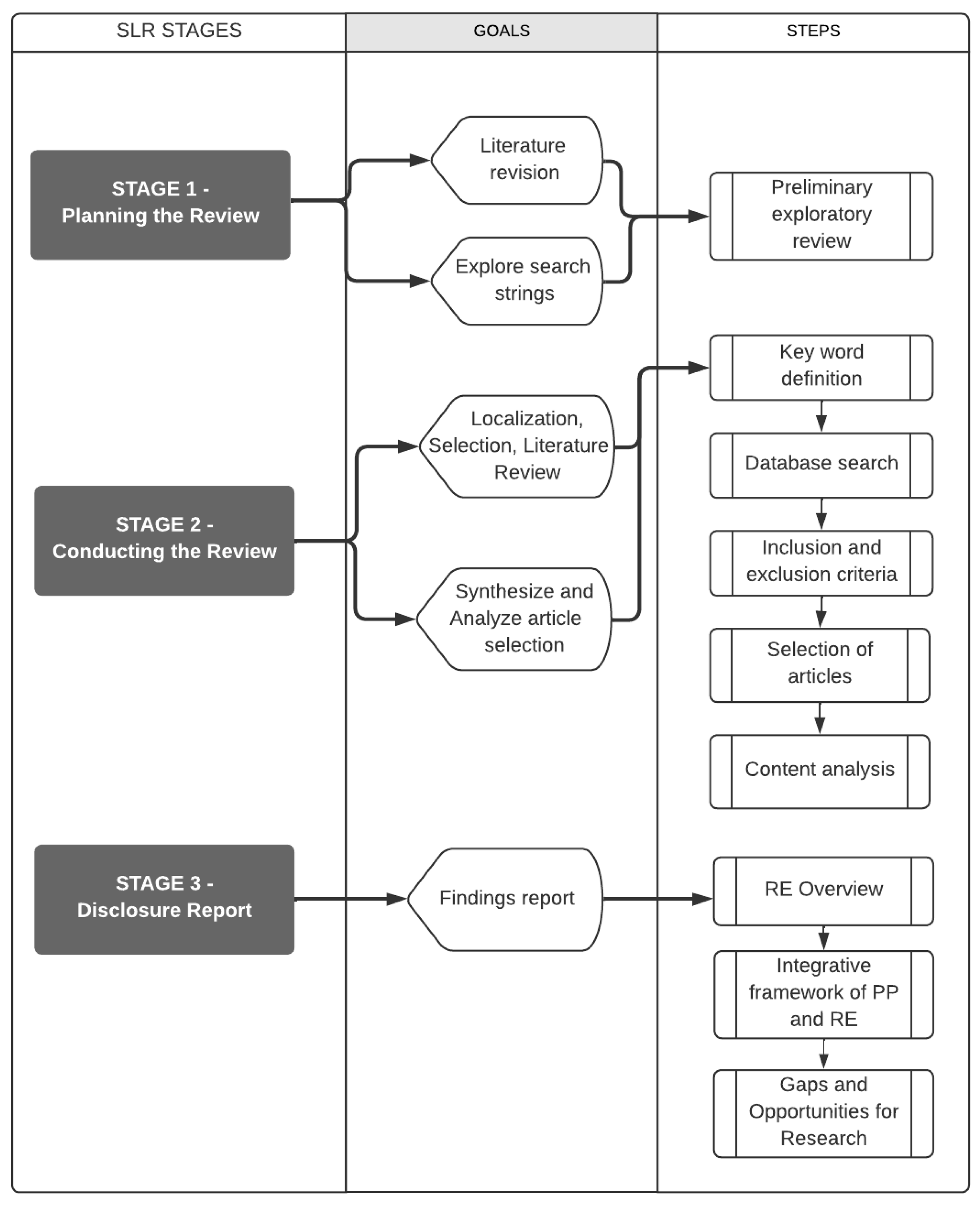
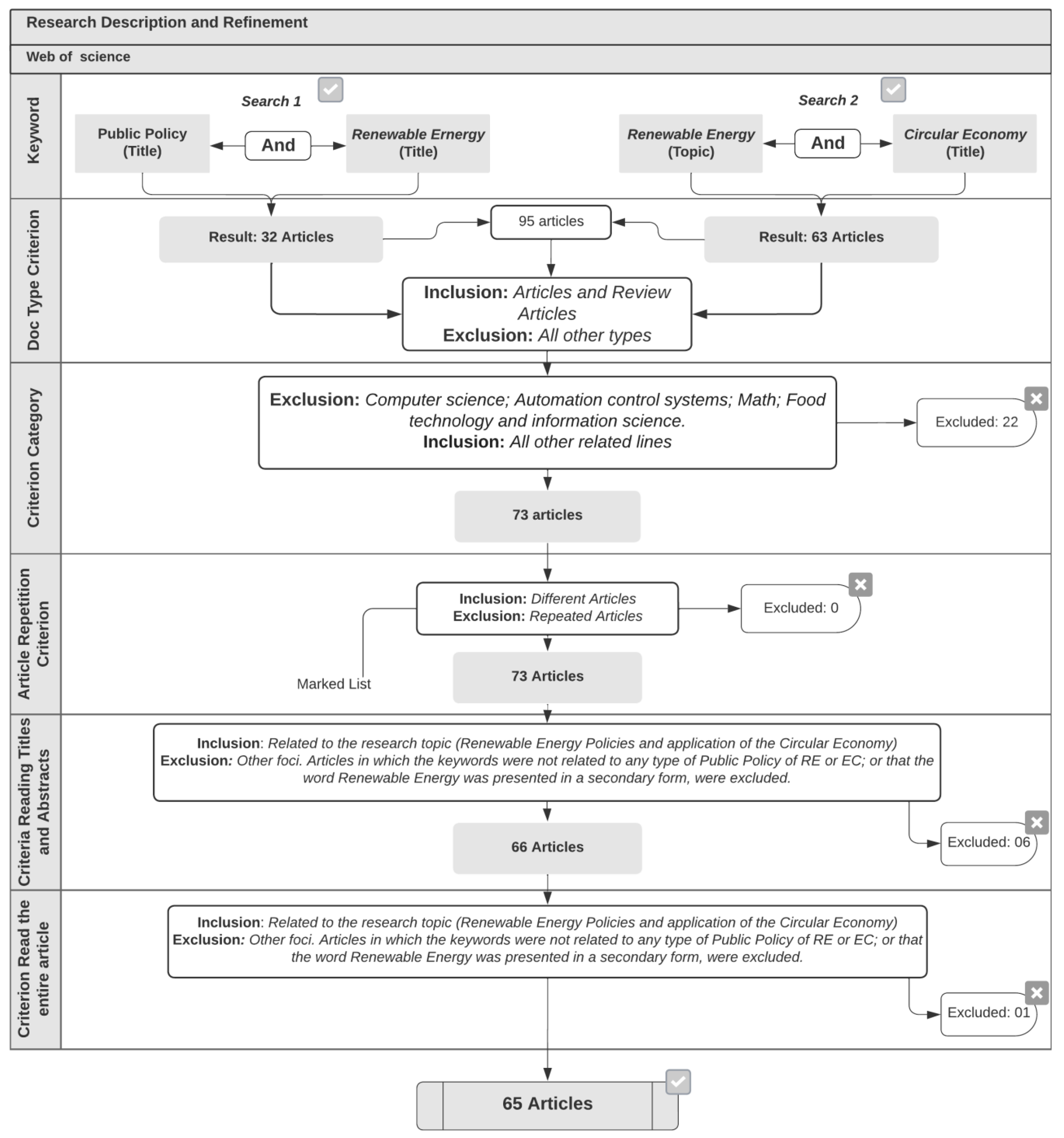


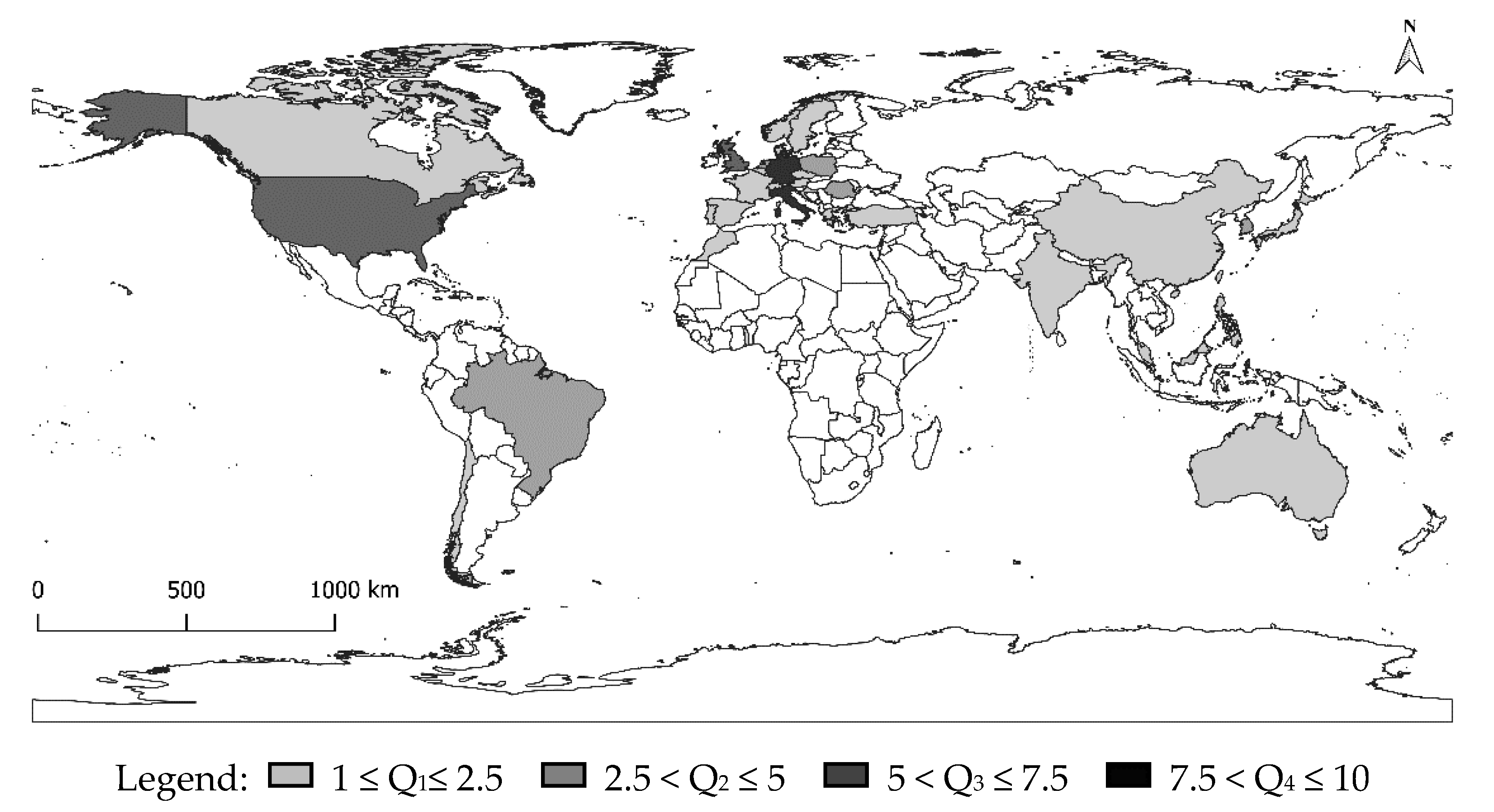
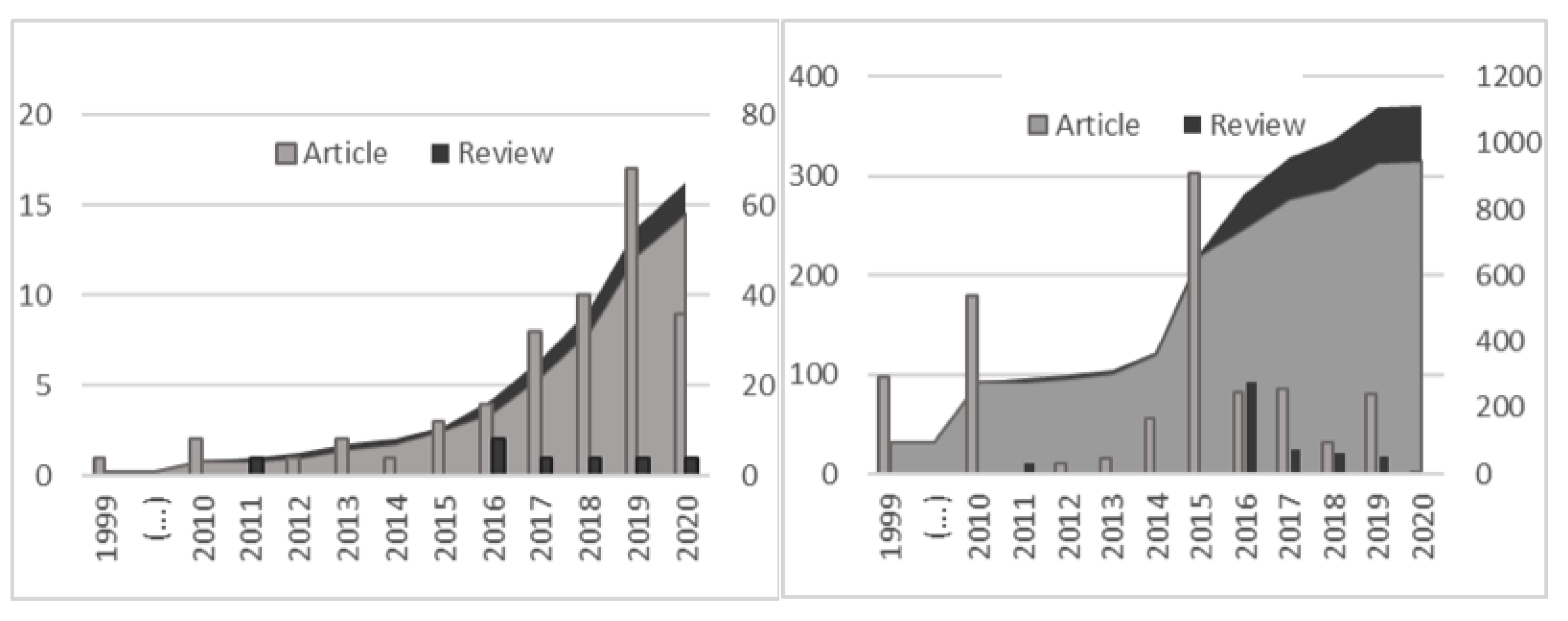
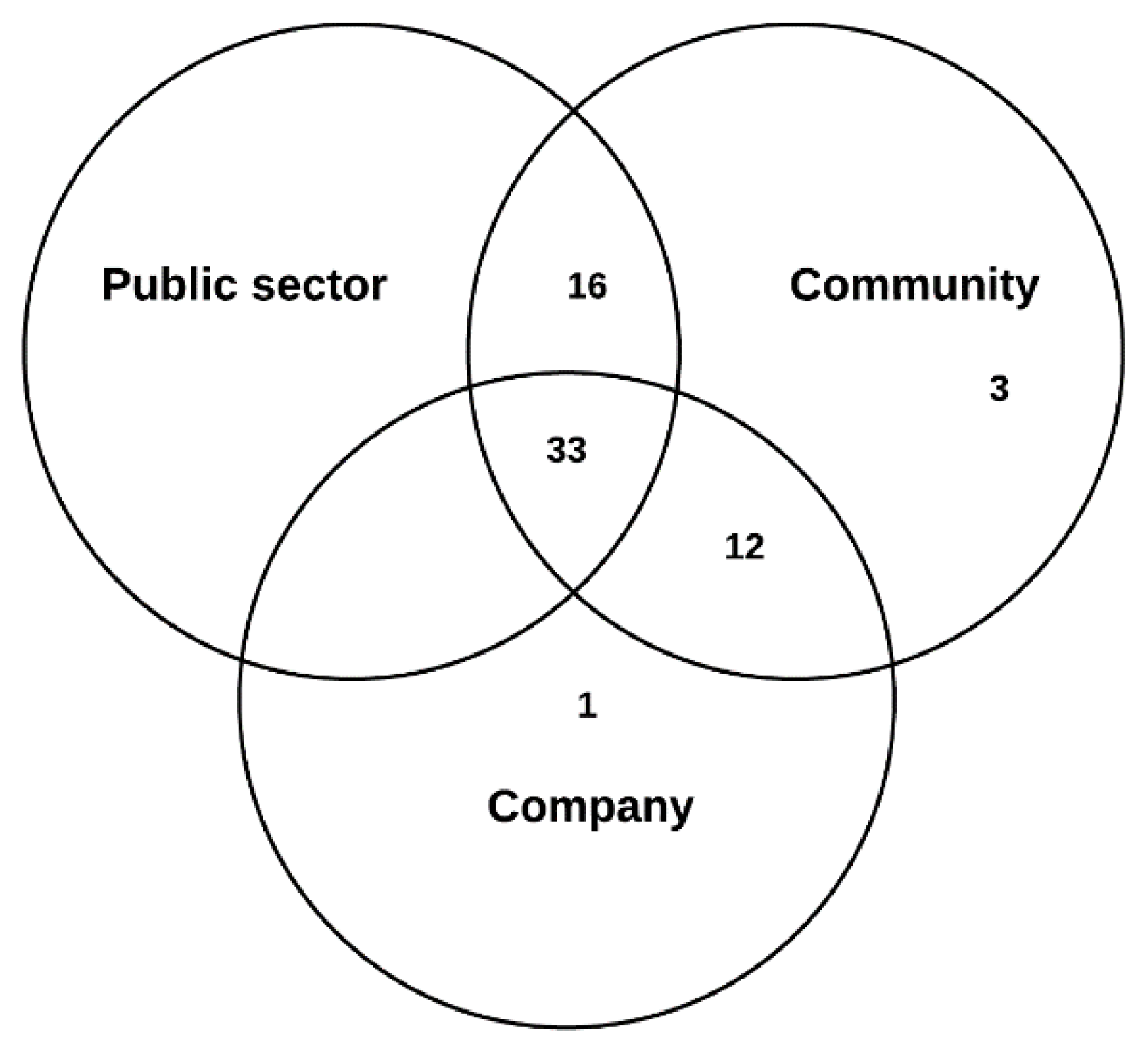
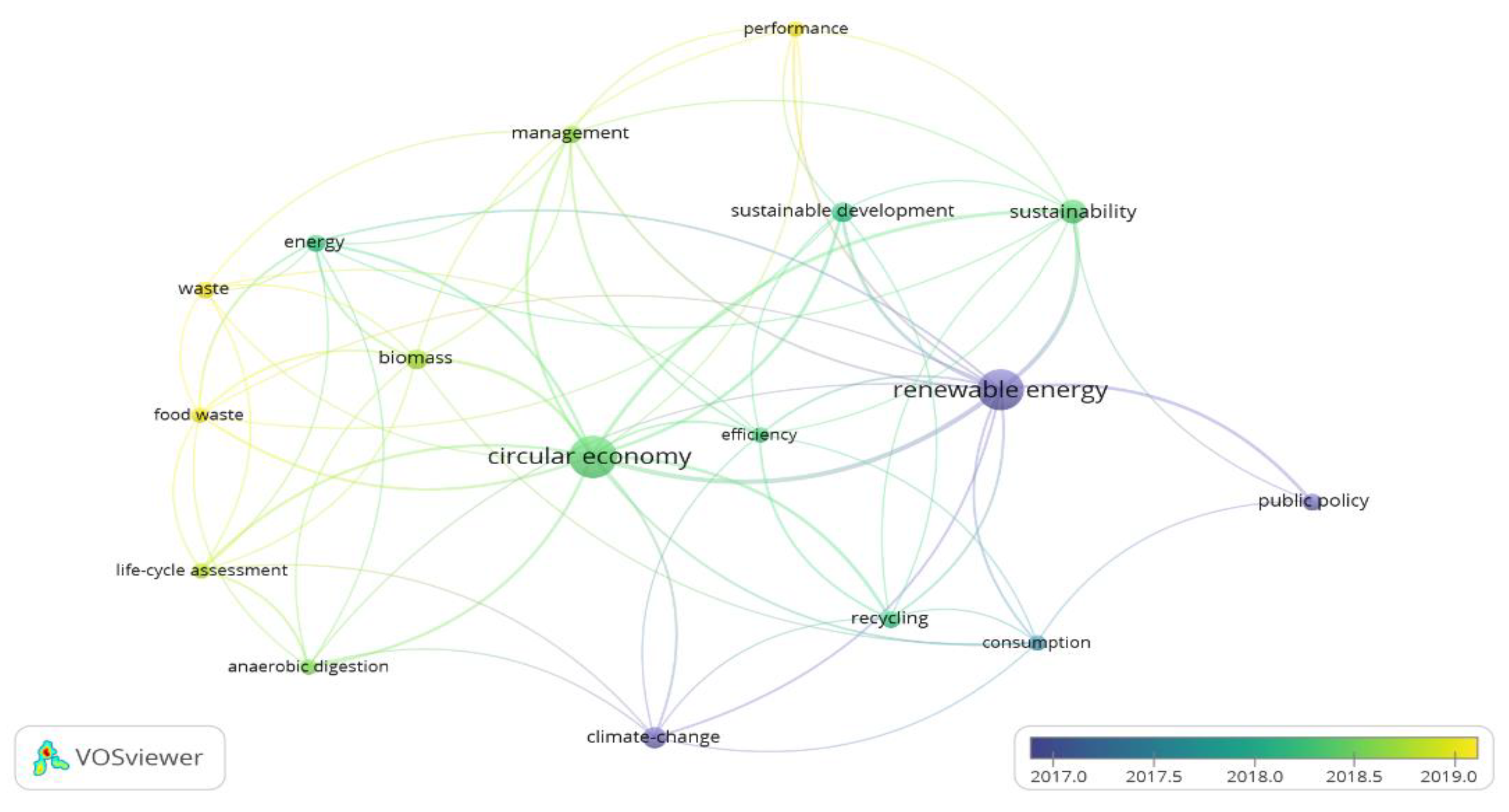

| PPRE Categories | Definition | Target Audience |
|---|---|---|
| PPRE 1 Distributive | They have specific objectives for the provision of state services and/or equipment. | Small groups or individuals from different social strata. |
| PPRE 2 Redistributive | Redistribute income in the form of financing for services and equipment and in the form of resources. | The higher strata of society are responsible for financing—through incentives—people with lower incomes. |
| PPRE 3 Regulatory | Regulatory policies are created to evaluate some sectors in order to create standards or implement services and equipment | All civil society. |
| Journal | Quantity | Citations |
|---|---|---|
| Energy policy | 9 | 460 |
| Journal of industrial ecology | 2 | 205 |
| Bioresource technology | 5 | 112 |
| Journal of cleaner production | 5 | 63 |
| Energy | 1 | 57 |
| Renewable and sustainable energy reviews | 3 | 41 |
| Nature energy | 1 | 40 |
| Resources conservation and recycling | 2 | 18 |
| Sustainability | 5 | 15 |
| Sustainable energy technologies and assessments | 1 | 11 |
| Entrepreneurship and regional development | 1 | 10 |
| Renewable energy | 1 | 10 |
| Sustainability science | 1 | 10 |
| Other journals | 28 | 63 |
| Total | 65 | 1115 |
| 1999 | 2010 | 2011 | 2012 | 2013 | 2014 | 2015 | 2016 | 2017 | 2018 | 2019 | 2020 | Total | ||
|---|---|---|---|---|---|---|---|---|---|---|---|---|---|---|
| Empirical | Previous Analysis | 1 | 3 | 1 | 4 | 9 | ||||||||
| Evaluation | 2 | 1 | 1 | 1 | 3 | 3 | 1 | 4 | 5 | 3 | 24 | |||
| Prospection | 1 | 1 | 2 | 4 | 2 | 5 | 5 | 20 | ||||||
| Subtotal | 1 | 2 | 1 | 1 | 1 | 1 | 3 | 6 | 8 | 7 | 14 | 8 | 53 | |
| Theoretical | Previous Analysis | 2 | 3 | 5 | ||||||||||
| Evaluation | 1 | 1 | 2 | |||||||||||
| Prospection | 1 | 1 | 1 | 1 | 1 | 5 | ||||||||
| Subtotal | 1 | 1 | 4 | 4 | 2 | 12 | ||||||||
| Total | 1 | 2 | 1 | 1 | 2 | 1 | 3 | 6 | 9 | 11 | 18 | 10 | 65 |
| 1999 | 2010 | 2011 | 2012 | 2013 | 2014 | 2015 | 2016 | 2017 | 2018 | 2019 | 2020 | Total | |
|---|---|---|---|---|---|---|---|---|---|---|---|---|---|
| Science and technology | 1 | 1 | 1 | 2 | 2 | 4 | 7 | 2 | 20 | ||||
| Research Article | 1 | 1 | 1 | 2 | 4 | 6 | 2 | 17 | |||||
| Review | 1 | 1 | 1 | 3 | |||||||||
| Agricultural Sciences | 1 | 1 | 1 | 2 | 5 | ||||||||
| Research Article | 1 | 1 | |||||||||||
| Review | 1 | 1 | 1 | 1 | 4 | ||||||||
| Environmental Sciences | 2 | 1 | 3 | 4 | 10 | ||||||||
| Research Article | 2 | 1 | 3 | 4 | 10 | ||||||||
| Social Sciences | 1 | 1 | 2 | ||||||||||
| Research Article | 1 | 1 | 2 | ||||||||||
| Economy and Business | 1 | 2 | 2 | 1 | 2 | 2 | 1 | 4 | 5 | 1 | 21 | ||
| Research Article | 1 | 2 | 2 | 1 | 2 | 2 | 1 | 4 | 5 | 1 | 21 | ||
| Energy and Fuels | 1 | 2 | 1 | 2 | 1 | 7 | |||||||
| Research Article | 1 | 2 | 1 | 2 | 1 | 7 | |||||||
| Total | 1 | 2 | 1 | 1 | 2 | 1 | 3 | 6 | 9 | 11 | 18 | 10 | 65 |
| Sources | Countries | Authors |
|---|---|---|
| Renewable energy (Lato sensu) | Germany; Latin America; Australia; Austria; Brazil; Canada; Chile; China; South Korea; Croatia; Spain; United States; South Korea; Greece; France; Italy; India; Ireland; Japan; Malaysia; Philippines; Czech Republic; Mexico; Portugal; Poland; Portugal; UK; Romania; Romania/Europe; Taiwan; Turkey; Switzerland; Turkey; Norway. | Marques et al. [6]; Gallagher et al. [7]; Priyadarshini and Abhilash [9]; Haas et al. [12]; Mihai et al. [13]; Ngan et al. [15]; Batista et al. [16]; Ünal and Shao [19]; West et al. [20]; Maciel et al. [41]; Sassanelli [42]; Dalmazzo-Bermejo et al. [44]; Lausselet et al. [47]; Gawel et al. [52]; Cascone et al. [53]; Desing et al. [54]; Katz-Gerro and Sintas [55]; Kılkış and Kılkış [56]; Stokes and Warshaw [57]; Bassi and Dias [58]; Doblinger et al. [59]; Antoniou et al. [60]; Aranda-Uso et al. [61]; Arnette and Zobel [62]; Arrese and Wells [63]; Baran [64]; Bertsch et al. [65]; Burger et al. [66]; Carfora et al. [67]; Chen and Kim [68]; Di Fraia et al. [69]; Fobissie [70]; Groh and Mollendorff [71]; Lee et al. [72]; Mavi and Mavi [73]; Nedelea et al. [74]; Olson-Hazboun et al. [75]; Polzin et al. [76]; Samperio and Acosta [77]; Skrinjaric [78]; Sung and Song [79]; Suwa and Jupesta [80]; Tsai [81]; Walker et al. [82]; Wysokinska [83]; Zamfir et al. [84]; Deutz et al. [85]. |
| Biogas | Brazil, Togo, Germany, Czech Rep. | Ribeiro et al. [86]; Azouma et al. [87] |
| Biomass | India; Ireland; Italy; UK; Brazil | Sherwood [40]; Stiles et al. [43]; Wall et al. [45]; Liguori and Faraco [88]; Sharma et al. [89]; Silva et al. [90] |
| Wind | Germany; United States; China | Loiter and Norberg-Bohm [38]; Barradale [39]; Hao et al. [49]; Schoden et al. [91] |
| Solar | South Korea | Kim and Park [92] |
| Solar, wind, biomass, natural gas | Germany | Liebe and Dobers [51] |
| Other sources | Netherlands; Poland | Meyer et al. [93]; Giezen [18]; Budzianowski [46]. |
| Description | Authors |
|---|---|
| Previous Analysis | Unal and Shao [19]; Sassanelli [42]; Stiles et al. [43]; Budzianowski [46]; Lausselet et al. [47]; Desing et al. [54]; Kılkış and Kılkış [56]; Antoniou et al. [60]; Burger et al. [66]; Chen and Kim [68]; Olson-Hazboun et al. [75]; Walker et al. [82]; Zamfir et al. [84]; Azouma et al. [87]. |
| Prospection | Gallagher et al. [7]; Priyadarshini and Abhilash [9]; Ngan et al. [15]; Batista et al. [16]; Giezen [18]; Loiter and Norberg-Bohm [38]; Dalmazzo-Bermejo et al. [44]; Wall et al. [45]; Hao et al. [49]; Gawel et al. [52]; Cascone et al. [53]; Katz-Gerro and Sintas [55]; Bassi and Dias [58]; Fobissie [70]; Lee et al. [72]; Samperio and Acosta [77]; Deutz et al. [85]; Ribeiro et al. [86]; Liguori and Faraco [88]; Sharma et al. [89]; Silva et al. [90]; Schoden et al. [91]; Kim and Park [92]; Meyer et al. [93] |
| Evaluation | Marques et al. [6]; Haas et al. [12]; Mihai et al. [13]; West et al. [20]; Barradale [39]; Sherwood [40]; Maciel et al. [41]; Liebe and Dobers [51]; Stokes and Warshaw [57]; Doblinger et al. [59]; Aranda-Uso et al. [61], Arnette and Zobel [62]; Arrese and Wells [63]; Baran [64]; Bertsch et al. [65]; Carfora et al. [67]; Di Fraia et al. [69]; Groh and Mollendorff [71]; Mavi and Mavi [73]; Nedelea et al. [74]; Polzin et al. [76]; Skrinjaric [78]; Sung and Song [79]; Suwa and Jupesta [80]; Tsai [81]; Wysokinska [83]. |
| CE Perspectives | Associated Assumptions in the Articles | Authors |
|---|---|---|
| Lifecycle analysis (focus on operations management) |
| Barradale [39]; Liebe and Dobers [51]; Aranda-Uso et al. [61]; Arnette and Zobel [62]; Carfora et al. [67]; Groh and Mollendorff [71]; Mavi and Mavi [73]; Walker et al. [82]; Ribeiro et al. [86] |
| Closed loop (focus in the operations management) |
| Marques et al. [6]; Gallagher et al. [7]; Mihai et al. [13]; Ngan et al. [15]; Maciel et al. [41]; Budzianowski [46]; Polzin et al. [76]; Deutz et al. [85]; Meyer et al. [93]. |
| Cradle to cradle (focus on operations management) |
| Antoniou et al. [60]; Silva et al. [90] |
| Double loop (emphasis on system management) |
| Stiles et al. [43]; Wall et al. [45]; Desing et al. [54]; Kılkış and Kılkış [56]; Stokes and Warshaw [57]; Bassi and Dias [58]; Baran [64]; Burger et al. [66]; Fobissie [70]; Sung and Song [79]; Suwa and Jupesta [80]; Zamfir et al. [84]; Kim; Park [92] |
| CE (focus on system management) |
| Priyadarshini and Abhilash [9]; Haas et al. [12]; Sassanelli [42]; Gawel et al. [52]; Katz-Gerro and Sintas [55]; Chen and Kim [68]; Lee et al. [72]; Nedelea et al. [74]; Olson-Hazboun et al. [75]; Wysokinska [83]; Liguori and Faraco [88]; Sharma et al. [89] |
| Reverse logistics (focus on operations management) |
| Sherwood [40]; Dalmazzo-Bermejo et al. [44]; Lausselet et al. [47]; Cascone et al. [53]; Bertsch et al. [65]; Di Fraia et al. [69]; Samperio and Acosta [77]; Tsai [81]; West et al. [20] |
| Industrial symbiosis |
| Batista et al. [16]; Giezen [18]; Loiter and Norberg-Bohm [38]; Doblinger et al. [59]; Hao et al. [49]; Azouma et al. [87] |
| Upcycle (emphasis on system management) |
| Arrese and Wells [63] |
Disclaimer/Publisher’s Note: The statements, opinions and data contained in all publications are solely those of the individual author(s) and contributor(s) and not of MDPI and/or the editor(s). MDPI and/or the editor(s) disclaim responsibility for any injury to people or property resulting from any ideas, methods, instructions or products referred to in the content. |
© 2023 by the authors. Licensee MDPI, Basel, Switzerland. This article is an open access article distributed under the terms and conditions of the Creative Commons Attribution (CC BY) license (https://creativecommons.org/licenses/by/4.0/).
Share and Cite
Nunes, A.M.M.; Coelho Junior, L.M.; Abrahão, R.; Santos Júnior, E.P.; Simioni, F.J.; Rotella Junior, P.; Rocha, L.C.S. Public Policies for Renewable Energy: A Review of the Perspectives for a Circular Economy. Energies 2023, 16, 485. https://doi.org/10.3390/en16010485
Nunes AMM, Coelho Junior LM, Abrahão R, Santos Júnior EP, Simioni FJ, Rotella Junior P, Rocha LCS. Public Policies for Renewable Energy: A Review of the Perspectives for a Circular Economy. Energies. 2023; 16(1):485. https://doi.org/10.3390/en16010485
Chicago/Turabian StyleNunes, Anna Manuella Melo, Luiz Moreira Coelho Junior, Raphael Abrahão, Edvaldo Pereira Santos Júnior, Flávio José Simioni, Paulo Rotella Junior, and Luiz Célio Souza Rocha. 2023. "Public Policies for Renewable Energy: A Review of the Perspectives for a Circular Economy" Energies 16, no. 1: 485. https://doi.org/10.3390/en16010485
APA StyleNunes, A. M. M., Coelho Junior, L. M., Abrahão, R., Santos Júnior, E. P., Simioni, F. J., Rotella Junior, P., & Rocha, L. C. S. (2023). Public Policies for Renewable Energy: A Review of the Perspectives for a Circular Economy. Energies, 16(1), 485. https://doi.org/10.3390/en16010485








